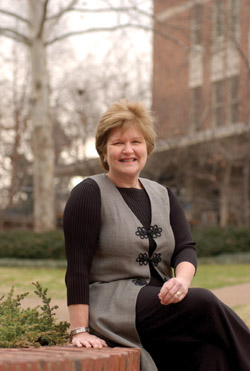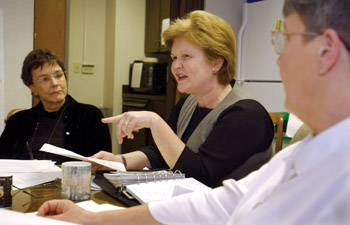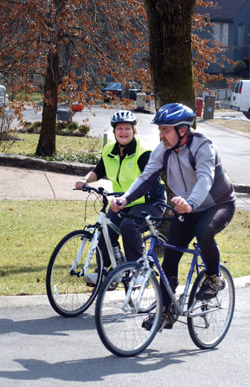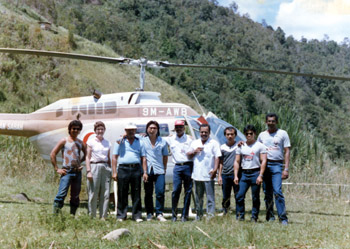
Dr. Mary Yarbrough, director of Health and Wellness, sits outside the Medical Center campus. The first female graduate of the School of Engineering’s Biomedical Engineering program, Yarbrough also completed medical school and her medical residency at Vanderbilt. Photo by Dana Johnson
Unconventional Wisdom

Yarbrough talks with her staff during the Health and Wellness manager's meeting, including Ellen Trice, left, and Diane Neighbors, right. Health and Wellness encompasses Health Plus, Work Life Connections/EAP, the Child Care centers, and the Occupational Health Center. Photo by Dana Johnson

Yarbrough and her husband Luke Wadley ride bikes together throughout the year, and spend time in warmer weather on the lake or in their backyard Chinese garden. Photo by Dana Johnson

Yarbrough's time as a Luce scholar took her to Borneo where she worked with a helicopter clinic called the “Flying Doctor.” Courtesy Mary Yarbrough
There is a point in some lives where a wonderful intersection of talent, interest and opportunity occurs; a moment in time when it becomes clear what the past has been leading to and a glimpse of where the future might lead.
For Dr. Mary Yarbrough, that intersection, that moment, occurred in Sabah, East Malaysia, on the island of Borneo, in 1985. It was at that unlikely place and time that Yarbrough knew that the road she had traveled had instilled in her a desire for a career in public health, and she could even glimpse what kind of career that desire could point toward.
The path she had traveled to that point had included riding with her mother, a public health nurse, down rural west Tennessee dirt roads to check on the health of children; it had included being the first woman to graduate from the Vanderbilt School of Engineering’s Biomedical Engineering program; it had included a medical degree and an internal medicine residency at Vanderbilt; and it included becoming a Luce Scholar, which had led her to the north of Borneo.
It was there where it all seemed to have come full circle, and where she seemed to have a map of what lay ahead.
But even when you have a good map, the road can be full of surprises. She didn’t really anticipate needing a second residency, or coming back to Vanderbilt to work. She didn’t see a cancer diagnosis coming. She certainly hadn’t planned to marry her high school sweetheart — at the age of 45.
Yarbrough cheerfully admits that the path of her life has not been a common one, or even a consciously planned one. Several times she has been willing to forge her own creative path against the grain of the conventional wisdom; she has lived her life with her eyes open to opportunity.
“When I think of Mary Yarbrough, I think of a highly energetic and highly intelligent individual,” says Kevin Myatt, associate vice chancellor and chief human resource officer. “She has a zest for knowledge and a zest for doing the right thing.”
A passion for prevention
Yarbrough really has two jobs. She is director of the Center for Occupational and Environmental Medicine, which provides external occupational health services to area employers, and which takes about 20 percent of her time. Her higher profile job, at least to staff and faculty, is as director of Health and Wellness for the University, which places her administratively over HealthPlus, Occupational Health, Work Life Connections/EAP and the Vanderbilt Child Care Centers.
Yarbrough views all of her responsibilities through the lens of helping and protecting employees.
“Our goal is to support the faculty and staff for health and productivity: physical health, mental health, prevention, child and family care — it all fits together so there’s this invisible net there for faculty and staff. The goal is to promote policies and provide programs that support the health and productivity of employees through the work setting.”
And she has a passion for doing everything possible to prevent disease. She knows and lives out the idea that the best medical care is the medical care that keeps people from getting sick.
“The choices we make given our social circumstances and the environment in which we live and work will be reflected in the diseases that occur in our lives,” she says. “Preventive medicine is that part of medicine that attempts to influence choice before harm is done or limit disease once it occurs. In the general community, it is called public health. In the workplace setting, preventive medicine is called occupational medicine.
“If there is something we can do as an employer to keep people from getting hurt or getting sick, then we need to do it,” she says.
“I think I’ll be a doctor.”
Yarbrough was born in Memphis, the youngest of four children, two boys and two girls. When she was six, her family moved to Toone, Tenn., in Hardeman County, her father’s hometown. But her father didn’t live to enjoy the life he had prepared there for his family; within a short time of the family move, he died of a heart attack at the age of 45.
Yarbrough’s mother had been a stay-at-home mom, but after the death of her husband, she picked up the career she had put on hold: public health nursing.
“My mother was always bringing home to us: ‘You have to get an education. You don’t ever want to end up in a situation where you have a family and you can’t support yourself,’” Yarbrough says.
This lesson wasn’t just taught with words in the Yarbrough family; Yarbrough’s mother was spending her days as a public health nurse driving the family Buick down the dirt roads of Hardeman County, checking after some of the most vulnerable citizens of the county — often with Yarbrough going along.
“My most vivid memory — there was this little girl who had been born with no legs,” Yarbrough recalls. “And she was about my age. Mother would go out to visit her home, an old clapboard house way off in the middle of a field. [Her mother] had about 11 kids. The way the little girl could get around was, she would push with her hands and travel all around like that. Whenever I think ‘public health,’ I see that old house with lots of people all over the place and that girl coming through the dirt.”
When adults asked her what she wanted to be when she grew up, all those days riding with her mother, watching the work and the influence of a public health nurse had not been lost on Yarbrough. Her standard answer was that she was going to be a nurse or a physical therapist.
But one day an uncle asked a follow-up question: “Why don’t you want to be a doctor?” It turned out he’d read an article about how a large percentage of the doctors in Russia were female.
Yarbrough said she’d just never thought about it. Then she sat a minute and did think about it. She was, even then, open to new ways of thinking, an openness that would serve her well in her career.
“O.K., I think I’ll be a doctor, then,” she said.
“And after that day, whenever anybody asked, I would say, ‘I’m going to be a doctor.’ It goes to show how you can influence lives,” she says of her uncle’s confidence in her. “I was so lucky.”
Yarbrough almost didn’t make it into Vanderbilt as an undergraduate. The guidance counselor at her high school didn’t take her goal to be a physician seriously and tried to steer her into University of Tennessee-Martin or Memphis State to study something “more realistic.”
Luckily, there was a teacher who believed in her.
Rebecca Vaughn, who was Yarbrough’s math teacher, knew how smart she was, and told the guidance counselor that if Yarbrough had a goal of going to Vanderbilt and being a doctor, then by George they would support her. Vaughn helped Yarbrough fill out the application and gather the necessary reference letters.
But Yarbrough was turned down. Her small rural high school had only offered foreign language classes at the same time as advanced math, and Yarbrough had opted for advanced math. Since Vanderbilt’s College of Arts and Science required a high school foreign language, she wasn’t eligible for admission. Along with the rejection came a ray of hope, though: Vanderbilt’s School of Engineering didn’t require a foreign language, and with her math skills, Yarbrough was a shoo-in for admission there — if she wanted.
She did. The young woman who wanted to be a doctor decided she was going to become an engineer first. Engineering students bound for medical school were told they needed to focus on either chemical engineering or biomedical engineering — which was a new program at Vanderbilt. Yarbrough, not a fan of chemistry, chose biomedical.
Where the boys are
Being a West Tennessee tomboy may not have been the best fit for the mid-‘70s sorority scene at Vanderbilt, but it paid off quite well in the long run. In the years after her father died, Yarbrough was quite accustomed to being the kid sister hanging out with her older brothers and their friends, and that easy companionship with males was a good fit in the male dominated worlds of engineering and then medicine.
“I knew how to talk to guys, how to get along with guys — better than I did with girls, really,” she says.
Another great mentor in her days at Vanderbilt was Ernest Jones, Ph.D., now an emeritus professor of Physics and Astronomy. “Dr. Jones asked me what I wanted to do [when I was still in my] first year at Vanderbilt, and I said I wanted to go into medicine. He said, ‘OK then, are you prepared to do what you have to do to get to medical school?’ There were probably about 10 of us that he was doing that for. He was a really cool guy,” she says with a smile.
“She was a good student and a strong person,” Jones, now 86, says. And he pays her what for a professor is perhaps the greatest compliment for a student: “She had a desire to learn and a desire to work.”
Then there was Dr. John Flexner.
Her hard work had allowed Yarbrough to finish engineering school a semester early, making her the first female graduate of the Biomedical Engineering program, and when she applied to the Vanderbilt Medical School, Flexner, professor of Medicine, was her interviewer. The interview was brief, gruff, and totally successful.
“He said, ‘You misspelled a word on your application and your English scores aren’t very good. About what I’d expect from an engineer.’”
He let that hang in the air for a minute, then out of left field came this: “’What do you think of socialized medicine?’ I told him I thought I agreed with the concept of providing health care to all people. He said ‘Good.’ And that was [pretty much] the interview.
“He must have given me a decent recommendation; I got in.”
Medical school and residency
Medical school was rough. “I thought I had studied in college, but this was beyond that,” Yarbrough says. “The first couple of years were depressing to me. I did well, but it was a whole different type of study.”
On the positive side, there were more serious, career-oriented women than she had encountered before. Or, as she puts it, “In medical school, I met more women like me.”
It was 1977, but it was still a man’s world.
“There was a neurosurgeon here who stood up and talked about how the females in the class really shouldn’t consider going into neurosurgery. [He said] it really wasn’t fair because [women] wouldn’t finish and there were only so many slots and the guys [would lose out].
“I raised my hand and said, ‘Excuse me, I think that sounded kind of insulting to me that you would say something like that.’ He said, No, no, no that’s just the facts and you are just being sensitive.’
“But then [classmate and current Obstetrics and Gynecology faculty member] Bruce Beyer spoke up and said, ‘Excuse me, but that’s the way I interpreted it, too.’”
It was support like that from Beyer that day that Yarbrough most remembers from her medical student days.
“There were a lot of people I started meeting who had really enlightened views on the world — which was great,” she says. “They were from all over the country and they would introduce you to new concepts. The whole world would open up. I went to New York for the first time and began traveling a lot.“
When the time came to choose a specialty and a residency, Yarbrough ultimately she settled on internal medicine, and matched at Vanderbilt.
“That three years is kind of a blur,” she says in a statement that many residents can relate to. “We were still doing every other night call at the VA. It was rough!”
But she learned she was good at it. She was a good doctor. But when the residency was almost over and her friends were lining up practices or fellowships, she still had no firm plans.
And that’s when a chance conversation brought her new information, caught her imagination, and had an enormous impact on her life.
Luce talk
One of the other residents at the VA with Yarbrough was Dr. Bruce Gellin, who became a Vanderbilt faculty member and is currently director of the National Vaccine Program at the department of Health and Human Services. During one middle-of-the-night conversation at the VA in the winter of 1984, Gellin and Yarbrough were discussing future plans and Gellin suggested she look into becoming a Luce Scholar.
The Luce Scholarship Program was created by Henry Luce, the founder of Time and Life magazines, and is for young professionals to spend time in Asia, and the more Yarbrough found out about it, the more excited she got.
But applications were soon due, and there was a lot of work to do. Dr. Phil Felts, the medical school faculty member who worked with students and residents at that time, made no secret of his disdain for the Luce plan. But Yarbrough was sticking with her gut feeling that this was right for her, and when Felts saw her determination, he helped her apply and brought his composition editing skills to bear on her application essay.
When the 15 Luce scholars were selected nationwide, Yarbrough was one of them. She learned she would be doing public health in the Sabah province of Malaysia, on the northern part of the island of Borneo. Her assignment was to work in a helicopter clinic called the “Flying Doctor.”
“They would fly us out into the jungle, leave us for two or three days, and we would do a clinic there, and we also had a small research project going about their community health. So what we were doing was flying out there and doing public health.”
Yarbrough and the team she was working with would do surveys of water, food, and shelter to learn about the general health of the people, and also look at what diseases and problems were common.
“It was fun, it was a good place, it was an adventure,” she says. “It was the best year of my life, I think. Everything new and different was happening. I was seeing stuff that I just couldn’t believe and learning so much.”
The jungles of Borneo are a long way from the dirt roads of West Tennessee, but it was there that Yarbrough found a place that felt like home. She may have been traveling in a helicopter instead of the family Buick, and she may have been looking after people who lived in bamboo huts instead of sharecroppers’ cabins, but this was it, what she had been looking for in a career.
“For the first time, I finally saw what it was I wanted to go into medicine for—there in the jungle in Borneo. I saw that thing that I had seen in the ‘60s in the South. I saw it there in its pure form again. It’s where you’re providing that infrastructure, you’re providing the basics of health care.
“From then on, I knew. There was never another doubt in my mind.”
Residency number two: Hopkins, Switzerland, Tanzania, Nashville
Yarbrough came back to Nashville to regroup. Now with a vision of where she was going, she plotted how to get there. She worked at some local ERs to pay off medical school debt and got some advice from Dr. Lewis Lefkowitz Jr., now professor of Preventive Medicine emeritus, that having her M.D. and a residency in internal medicine wasn’t enough. She needed a second residency with a master’s degree in public health (MPH). She applied and was accepted to the residency program at Johns Hopkins. During her residency, which was in preventive medicine with an international emphasis, she would work on the MPH.
After a year of classes to meet the final requirement of her residency, Yarbrough served a one-year stint as a consultant based in a location somewhat more picturesque than Vanderbilt ICUs or the Nashville VA: she was based in Geneva, Switzerland, at the headquarters of the World Health Organization, and had a field project working at a diarrheal disease program in Tanzania.
In the summer of 1991, Yarbrough came back to the U.S. with her experiences in public health in the third world, and wondered where she would live and work for a year to complete her Hopkins residency requirements.
She returned to Nashville where she worked as the director of environmental epidemiology for state of Tennessee. And it was that job with the state that led her back to Vanderbilt; she worked there with Dr. Eugene Fowinkle, who was impressed enough with her that when an opening as director of the Occupational Medicine Program came up at Vanderbilt, Fowinkle, who had by that time taken a position as associate vice chancellor for Health Affairs at VUMC, recommended Yarbrough for the job.
“Cancer made me a
better doctor”
There was something else going on with Yarbrough during the time that she was completing her residency. She had a swollen lymph node on her neck that seemed odd to her, and was plagued by various small nagging complaints: mouth ulcers, infectious diarrhea, skin infections, a few other things.
She saw various doctors over about five years, none of whom believed that any of this amounted to anything other than the random bodily discomforts of life. But something kept nagging in the back of Yarbrough’s brain saying that something about this wasn’t right.
In the fall of 1994, she approached Dr. Kenneth Hande, a faculty member she remembered from her residency days (that is, her first residency at Vanderbilt) in the hallway following grand rounds. After an exchange of pleasantries, she brought up her suspicions.
Hande took her concerns seriously. That afternoon, he arranged to have a biopsy taken of the lymph node. A week later she had a diagnosis of cancer — Hodgkin’s lymphoma.
The physical disease was debilitating enough — chemotherapy and its exhaustion was dragging her down while she was still working, still going to exercise class, and doing everything she could to remain in denial that anything important was going on. She lost her hair, the steroids she was on led to dramatic weight gain, and she was terrified inside that she was somehow responsible for her own illness.
“After all,” she thought, “if you’re such a good doctor, why are you sick?”
Her anger at the disease and the losses it was inflicting on her body, mind, and self-image was even leading her to push away those who cared for her. She realized that she needed help to deal with the stew of rampaging feelings; one day she took action: she picked up the phone a called a psychiatrist who somebody had recommended.
It was a great decision for her. Slowly, she confronted the feelings she had kept down, not only about the disease but about losing her father so young, about cloddish comments from others, about the death of the invincible image of herself that she had dubbed “Superdoctor.”
“I don’t think you can see the stages of grief while you are in them,” she says. “I hope I can return the many acts of kindness shown me during that time.”
And if somebody asks if having cancer made her a better doctor, she doesn’t even have to think.
“Oh, God, yeah,” she says. “It’s given me a lot of compassion for people with illnesses and a lot of perspective on what it’s like for you when you’re sick and trying to understand it. It put in perspective the frailty of mankind, if you will.”
Love, actually
At age 45, Yarbrough had a flashback to her youth. Here she was kissing Luke Wadley, her high school sweetheart again. They dated for a couple of years, got to know each other again. He proposed on the Fourth of July, 2000, at Ripley’s Believe it or Not Museum in Gatlinburg. They were married the next year beside a lake on the family farm in Toone.
“I now have two [step-]daughters and a grandson. And I didn’t have to go through all the…” the thought dissolves in a wave of laughter, the laughter of a person who has followed dreams even when she couldn’t always see them clearly, who let her intelligence, her instinct, and her imagination carry her down unconventional paths, and has no complaints about how things have turned out.
“I can honestly say I’ve never regretted a moment of it,” she says. “I mean I’ve had bad days, or bad periods where I didn’t like maybe the direction for a while. But I’ve not really ever been bored, or felt like I’ve missed anything, or felt like I haven’t achieved what I set out to do.”













